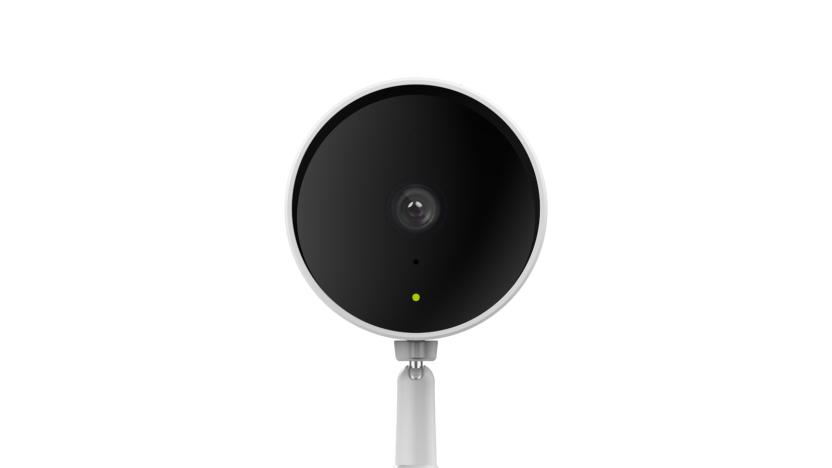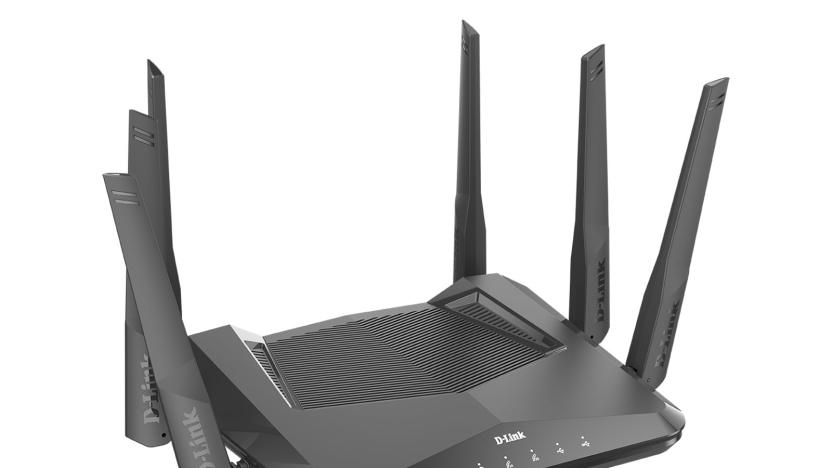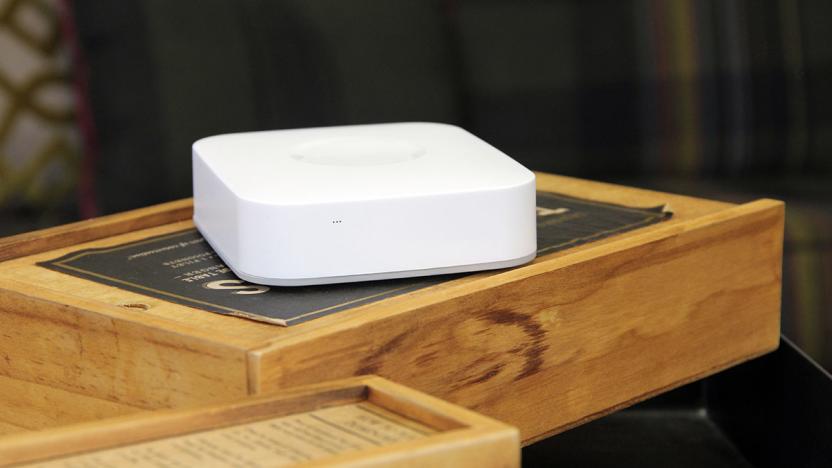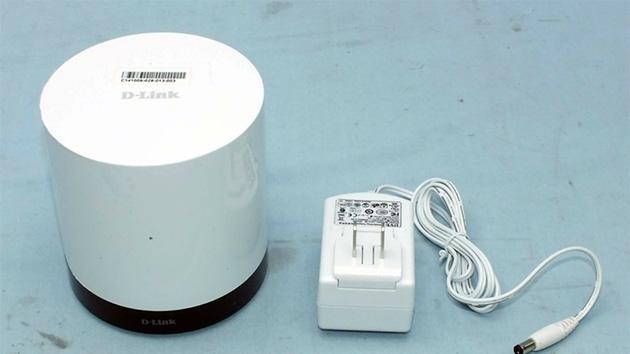d-link
Latest

D-Link brings AI-powered person detection to its home security cameras
Ahead of CES, D-Link is bringing new features to its home security cameras. Today, the company announced that its devices can now detect people and breaking glass. The added capabilities are powered by AI that runs on the edge, and D-Link says it's able to provide faster, more accurate results than it would with cloud-powered AI.
Christine Fisher01.03.2020
D-Link's latest routers pack WiFi 6 and mesh networking
It wouldn't be CES without an avalanche of WiFi routers, and D-Link is certainly contributing its share. It's coming to the show with no less than nine (!) offerings, all of which include mesh networking to help set up strong coverage across a whole home. They also have "enhanced," profile-driven parental controls that are reportedly easy to set up, and five models support the added speed of WiFi 6 if you're looking to future-proof your network.
Jon Fingas01.03.2020
D-Link agrees to 10-year security assessment to settle FTC lawsuit
D-Link has settled a two-year-old lawsuit filed by the FTC over its products' insufficient security, and it has agreed to a few conditions to put the issue to bed. To start with, the company is required to implement a comprehensive software security program, which includes testing products for vulnerabilities before they're released, ongoing monitoring of its products to address security flaws, automatic security updates and accepting vulnerability reports from security researchers.
Mariella Moon07.03.2019
D-Link's latest router uses 5G for super fast home broadband
D-Link has launched a gateway router that shows 5G could be as much about home internet as faster mobile connections. The DWR-2010 5G NR router will pick up 5G networks and deliver speeds to your home as fast as 3Gbps, "more than 40 times faster then the [average] fixed broadband speed in the US," it said. It will reportedly be relatively easy to setup, letting you create a home WiFi network with just a power outlet and SIM card.
Steve Dent01.04.2019
Data-stealing router malware bypasses web encryption
A recently discovered strain of router malware appears to be much worse than thought. Cisco Talos has learned that VPNFilter can not only render devices unusable, but can bypass the SSL encryption you often see on the web. A module in the malware intercepts outgoing web requests to turn them into non-secure (that is, basic HTTP) requests, helping it steal sign-ins and other sensitive data when possible. It can also use man-in-the-middle attacks to insert hostile JavaScript into outside websites, and target devices beyond the router itself, such as PCs on the local network.
Jon Fingas06.06.2018
Can Facebook really apply the EU's data-privacy rules worldwide?
During his testimony in front of the House Energy & Commerce Committee on Wednesday, Facebook CEO Mark Zuckerberg stated that Facebook would adopt the European Union's General Data Protection Rules (GDPR) as its privacy standard moving forward. This marks an evolution in Zuckerberg's position on the issue, having told Reuters earlier this month that he only agreed "in spirit" with the laws. If Zuckerberg follows through with this promise, it could have a significant impact on Facebook users around the world.
Andrew Tarantola04.12.2018
FTC lawsuit over D-Link’s lax router security just took a big hit
In January, the Federal Trade Commission (FTC) took D-Link to court over its incredibly insufficient security. The FTC claimed that the company failed to protect its routers and IP cameras from unauthorized access, exposing them to use in botnet attacks or outside viewings of camera feeds. But this week, the FTC's case against D-Link took a hit as a judge dismissed three of the commission's six complaints.
Mallory Locklear09.21.2017
D-Link would like you to forget about its lax security
Back in January, the US Federal Trade Commission accused D-Link of putting customers in harm's way with its extremely negligent approach to security. According to the FTC, the company left hundreds of thousands of customers vulnerable to attack by failing to secure their routers and cameras against critical vulnerabilities. At the time, the company denied the allegations, claiming no one had been affected by an actual breach, but that didn't change the fact that D-Link left crucial security information out in the open for months. Now the company is trying to have the case thrown out of court on the grounds that the US government has no jurisdiction over the company.
Andrew Dalton05.11.2017
FTC vs D-Link: All bark, no bite
Most routers are bad. Bad to their little router bones. But they were made that way. And when you get one of the bad ones in your home, they sit there like little privacy and security time bombs, just waiting to become conduits of evil in your house. You think I'm joking. But if you look at the state of router security, then you will know this is a big problem. And it's one that's nearly impossible for normal people to fix.
Violet Blue01.13.2017
FTC drags D-Link into court for lax router and camera security (Updated)
When you buy a router or other internet-connected device from a company as well known as D-Link, you expect a high standard of security. Many of D-Link's products are advertised with these kind of claims, which is part of the reason the US Federal Trade Commission is suing the company in a California court. In legal action launched yesterday, the FTC has accused D-Link of putting consumers at risk with its lax approach to hardware security.
Jamie Rigg01.06.2017
The best smart leak detector
By Rachel Cericola This post was done in partnership with The Wirecutter, a buyer's guide to the best technology. Read the full article here. After spending over 10 hours pouring water, mopping it up, and changing wet socks to test the performance of seven DIY leak detectors, we've decided that the D-Link DCH-S160 Wi-Fi Water Sensor is the best smart water sensor currently available. It's one of the few options that doesn't need a smart-home hub, making it a more affordable solution than the competition because it can work with your existing Wi-Fi network. It can—like the rest of the units we tested—deliver alerts whenever water is present, but it also throws in a few perks that aren't available on any other smart water sensor at this price.
Wirecutter09.30.2016
Leaked D-Link code-signing key could make malware look legit
When your company is known for making wireless routers, network switches and home security cameras, leaking your code-signing private keys yourself is the last thing you want to do. Back in February, that's exactly what D-Link did, accidentally leaving a valid key visible in its open-source firmware. If found by an attacker, the key could have been used to make malware that can pass as official software from D-Link -- malware that wouldn't trigger security warnings when installed to Windows or OS X machines.
Sean Buckley09.18.2015
Samsung's next-gen SmartThings home hub goes on sale
The next generation of SmartThings hardware is now available after a lengthy delay. Samsung purchased the home automation company just over a year ago, but was optimistic when it said the next-gen hardware would arrive in April. The hub, sensors and app (available on iOS and Android) are now good to go, however, along with developer tools to get other companies on board. The new hub improves on the last version in a couple of key ways. It no longer needs an internet cloud connection to function, and can run autonomously for 10 hours on a battery if the power is cut.
Steve Dent09.03.2015
The best Wi-Fi extender (for most people)
This post was done in partnership with The Wirecutter, a list of the best technology to buy. Read the full article here. We spent a total of 110 hours researching 25 different Wi-Fi extenders (and testing 10 of them), and the $100 Netgear EX6200 is the one we recommend for most people right now. It costs as much as a great router—but it has the best combination of range, speed, flexibility, and physical connections of any extender we tested.
Wirecutter07.31.2015
CES 2015: The home of the future, available today
We've been hearing about the promise of the connected home, or the "Internet of Things," for years. At this CES, one thing became clear: The connected home of the future is achievable today. Qualcomm's smart home, for example, was a mock-up showing how tech could change the way we live. Unlike past years, however, the vast majority of "things" on show were off-the-shelf products you could buy and install in your apartment right now.
Aaron Souppouris01.11.2015
D-Link wants to invade your home with security cameras and leak sensors
Night-vision baby monitors, pan-and-tilt security cameras and water leak sensors? D-Link's smart home product division loves CES, and an earlier connected home hub leak showed that it would be especially active this year. The company has formally revealed its first hub (the $80 DCH-G020) to support both WiFi and Z-Wave devices, along with some peripherals to go with it. As expected, it plugs into a regular router and lets you control a raft of either Z-Wave or WiFi accessories using the mydlink app for iOS or Android devices. Giving the hub some utility are the $40 Z-Wave DCH-Z110 open/close and $50 Z-Wave Motion sensors, along with the DCH-S160 WiFi water sensor and DCH-S220 WiFi siren ($60 and $50, respectively). All of those devices will be available sometime next quarter.
Steve Dent01.05.2015
D-Link's new routers look crazy, but they're seriously fast
D-Link has just jumped the router shark with its latest AC5300, AC3200 and AC3100 Ultra Performance models. On top of speeds up to 5.3Gbps for the AC5300 model, the 802.11ac devices feature, um, striking looks that hopefully won't frighten animals or small children. D-Link calls the models "attractive" with a "modern form factor for today's homes," and we'd agree -- provided you live in some kind of rouge-accented spaceship. Performance-wise, however, the new models are definitely drool-worthy, thanks to 802.11ac tri-band beamforming speeds between 3.1 and 5.3 Gbps, along with Gigabit Ethernet, high-power antennas and onboard USB 3.0 ports.
Steve Dent01.05.2015
D-Link's latest smart home hub lets you add devices with a scan
How cheap is too cheap? D-Link has found the sweet spot between low-priced, but low-quality smart home systems (from the likes of Archos) and pricey security systems. It's now planning on opening up its system to many more accessories, judging by the DCH-G020 connected home hub that just passed through the FCC. The system will likely bow next month at CES 2015, but the US wireless regulator has revealed quite a bit, including manuals and photos. The hub will control Z-Wave (low-power RF) as well as WiFi devices, meaning it'll work with third-party alarms, detectors and cameras on top of existing D-Link WiFi cameras and accessories.
Steve Dent12.26.2014
D-Link DCS-930L webcam keeps an inexpensive eye on your world
I do a lot of playing around with webcams. Years ago I wrote a long screed about how difficult it was to get a FOSCAM PTZ (pan-tilt-zoom) webcam set up in my house for security while we were on a trip. That device was incredibly hard to get working with OS X at the time, and I actually ended up having to use a virtual Windows machine to get it working. I've also tested and in some cases purchased webcams from both IZON and Dropcam, the latter being my current favorite for image quality and ability to be set up from an iOS device. But sometimes you just need a cheap webcam, and that's where the D-Link DCS-930L (US$35 through Amazon) comes in. So, what was I connecting to my "Internet of Things" this time? I have a professional-quality weather station that I use to send updates of weather conditions to Weather Underground every few seconds. The one thing my station was missing? A webcam showing a visual of current weather conditions. All I needed was a camera that would keep an eye on the outdoors. I started by looking at outdoor webcams, most of which started at $200 and went up from there. Not wanting to spend a lot of money on this somewhat frivolous "need", I started looking at cameras that would be able to just look out a window during the day -- no need for IR lights or pan-tilt-zoom. And that's what pointed me to the D-Link DCS-930L. Before ordering the webcam, my first step was to make sure that it was going to be OS X or iOS compatible for setup. Although there were a number of Amazon complaints from Mac users griping about how hard it was to set up, I noticed that there is a Mac setup app called the Setup Wizard that is available for download from D-Link's site. For "turn it on and it works" ease of use, you'll need to get an IZON or Dropcam. But this D-Link webcam didn't take much time at all to get working. I just needed to plug the webcam into an Ethernet hub, plug my MacBook Pro into the same hub, let it search for and find the camera, and then pass the Wi-Fi settings to the D-Link webcam. Unplug the Ethernet, and then the camera was moved to its final resting place in a front window of my house. The image isn't exactly HD, but when I can get 640 x 480 color imagery at 20 frames per second, that works. After all, the idea here is just to have one picture taken every minute anyway. To get the webcam to send a photo to Weather Underground once a minute, I'm using Evological's EvoCam ($30) software. This app is able to use the incoming network camera feed from the DCS-930L and a variety of other webcams, and it was drop-dead simple to get it configured to FTP an image every 60 seconds to the Weather Underground servers. I should note that many of D-Link's webcams connect to the company's free "MyDLink Cloud" service for remote viewing; the company also has a number of free iOS apps available to make it possible to view what your camera is seeing. I downloaded the MyDLink Lite app, and it works well for both viewing the camera and updating firmware. No bells and whistles, but sometimes that's just what you need. Conclusion While this isn't an "official" TUAW review, it does show just how sometimes the least expensive options provide perfectly workable solutions to a problem. While it might be difficult for some users to set up, anyone with a bit of experience should have a DCS-930L up and running in minutes. The free app is perfectly workable, and the camera works well with other applications like EvoCam. Rating: 3-1/2 stars out of 4 stars possible
Steve Sande06.05.2014
D-Link hits CES with portable router and charger combos, WiFi range extenders and surveillance equipment
With the exception, perhaps, of the traditional trade show flu, nothing's thicker in the air CES than overlapping WiFi signals. Phones, PCs, SmartTVs, game consoles, tablets and routers are all desperately reaching out to something to connect to, and D-Link is happy to oblige. This year, the company is debuting the DIR-510L, a $100 portable router that doubles as a device charger. In addition to crafting wireless and ethernet signals into a local hotspot, this router can stream content from connected USB devices, share files wirelessly from any device plugged into its two USB ports and even charge gadgets with its built-in 4000mAh battery. If the diminutive router's range is too short for you, the firm is offering a pair of dual-band WiFi range extenders for $60 and $90, depending on how much bandwidth you need. That extended network area will come in handy if you pick up D-Link's new WiFi Baby Camera, a lightweight child monitor that lets you peek in on your children from any device with a WiFi or cellular internet connection. The $180 shooter is outfitted with night vision, temperature and motion sensors and can even play pre-recorded lullabies on cue. If you're looking for something a bit more advanced, the company is also showing off a new mydlink Network Video Recorder for small businesses -- a $380 surveillance system with remote access, up to 4TB of video storage space and support for nine cameras. The gadgets are all being shown at CES 2014 this week, but you can find the details at the company's product pages in the adjacent source links.
Sean Buckley01.06.2014